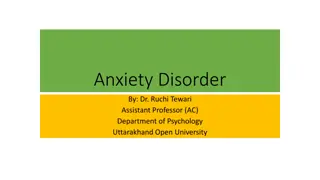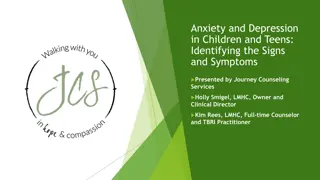Collaborative Approach to Treating Anxiety: Comprehensive Care Strategies
Collaborative care in treating anxiety involves a thorough assessment, differential diagnosis, treatment planning, and client education. Providers should be empathetic, challenge stigma, and consider comorbidities. Interactions with clients should acknowledge individual interpretations of symptoms and coping mechanisms, while interventions include clinical interviews and consultation with the treatment team.
Download Presentation

Please find below an Image/Link to download the presentation.
The content on the website is provided AS IS for your information and personal use only. It may not be sold, licensed, or shared on other websites without obtaining consent from the author. Download presentation by click this link. If you encounter any issues during the download, it is possible that the publisher has removed the file from their server.
E N D
Presentation Transcript
Treatment of Clients Experiencing Anxiety A Collaborative Approach to Care February 24, 2018 * Tex-CHIP Training Series
Psychological Assessment of Anxiety Symptoms
Understanding Provider Role in Treating Anxiety Within a multi-disciplinary team approach, a thorough and comprehensive assessment is an essential initial step in first making a differential diagnosis and then establishing a primary diagnosis which then informs treatment planning. Conduct clinical interview and/or review clinical interview information. Administer/score/interpret assessment instruments. Share assessment results and diagnostic impressions with treatment team. Discussion of additional info needed to inform diagnosis and treatment plan (e.g., medical exam, lab work, medication evaluation). Summarize assessment results and communicate results to client. Educate client about their anxiety diagnosis in a non-stigmatizing way
Understanding Provider Role in Treating Anxiety Informal versus Formal Assessment. Clinical interview and brief assessment versus more comprehensive formal assessment (e.g., psychological battery). May depend on protocols and resources available at a given site. Many brief symptom checklists only screen for generalized anxiety disorder and panic symptoms not social anxiety, PTSD, phobias, or OCD.
Considerations when Interacting with Clients Understand that clients have their own interpretation of their anxiety symptoms and reactions to these symptoms (e.g., fear, shame, confusion, resignation, overwhelmed, hopeless). Importance of communicating empathy for their struggle, emphasizing strengths, and challenging stigma related to mental health issues. There is often comorbidity of anxiety with other diagnoses. Often anxious individuals are highly motivated to feel better and want to understand their symptoms. Some clients with anxiety may have a history of self-medicating with alcohol or other drugs or food. Avoidance is a common coping mechanism
Goals & Related Interventions Goals: Gather information about client s concerns, psychiatric history, history of current symptoms, social history, cultural variables, developmental factors, functioning, & reason for seeking treatment Rule out malingering, substance abuse, and disorder due to general medical condition Assign diagnosis Interventions: Clinical interview Consultation with treatment team Administration of assessment tool(s) Written summary of assessment results Review of assessment results with client
Measuring Outcomes/ Success Administering assessment tool at regular intervals or every session to track reduction in symptoms Pay attention to client s subjective description of how they are feeling and functioning Goal is for client to learn to effectively manage anxiety symptoms which typically results in a reduction in the severity and frequency of symptoms. Important that client understands that treatment won t eliminate anxiety completely. If symptoms aren t getting better, discuss with treatment team. Does treatment plan need to be modified? Consider other contributing factors (e.g., environmental factors, personality disorder, health issues, medication). May need to do additional assessment.
Communication from Counselors Assessment and monitoring treatment response is an on- going process and each member of the treatment team contributes relevant information. Depending on the setting, counselors and/or case managers will likely have the most contact with clients and may observe or identify factors which are important to consider in assigning and/or revising a diagnosis and making modifications to the treatment plan.























